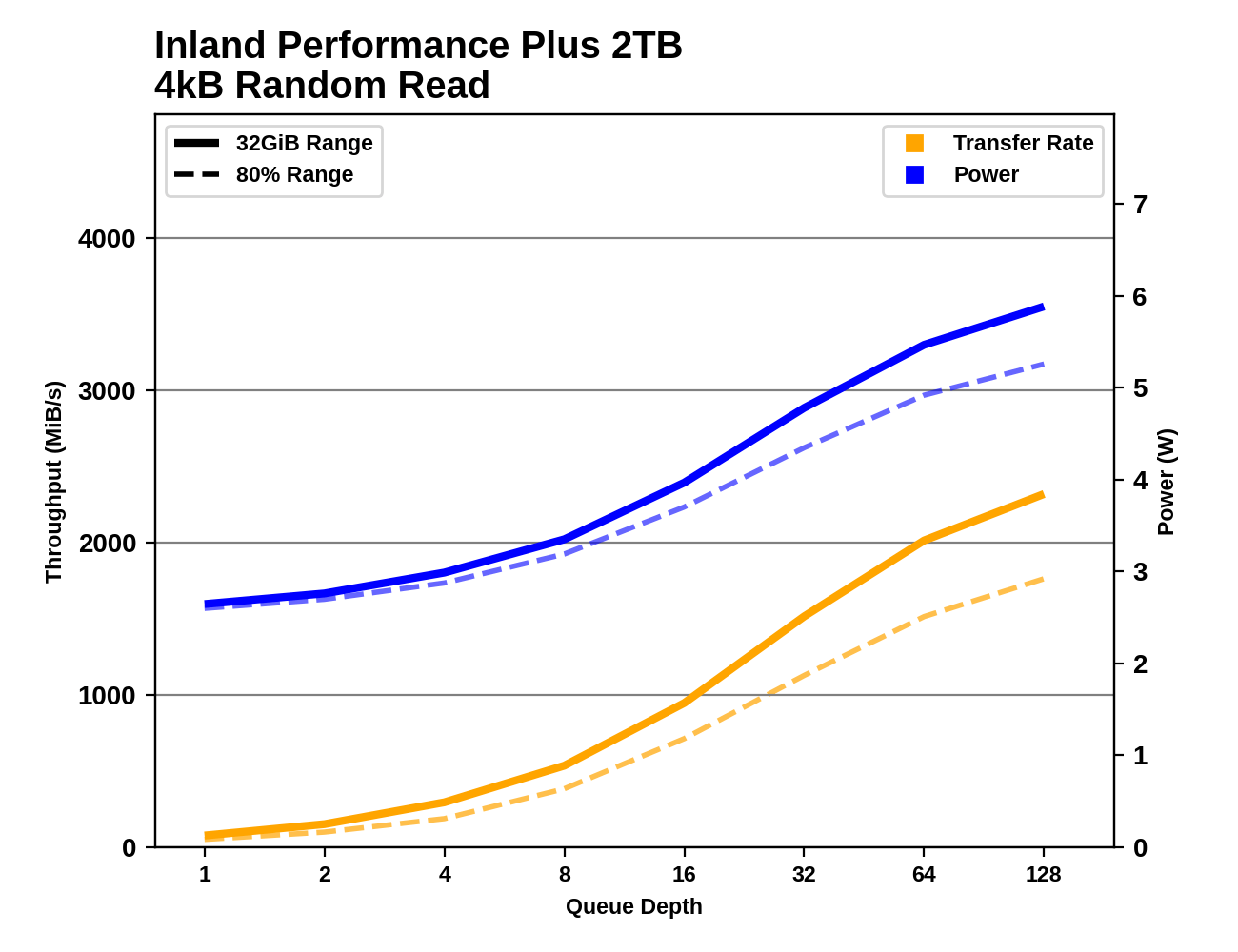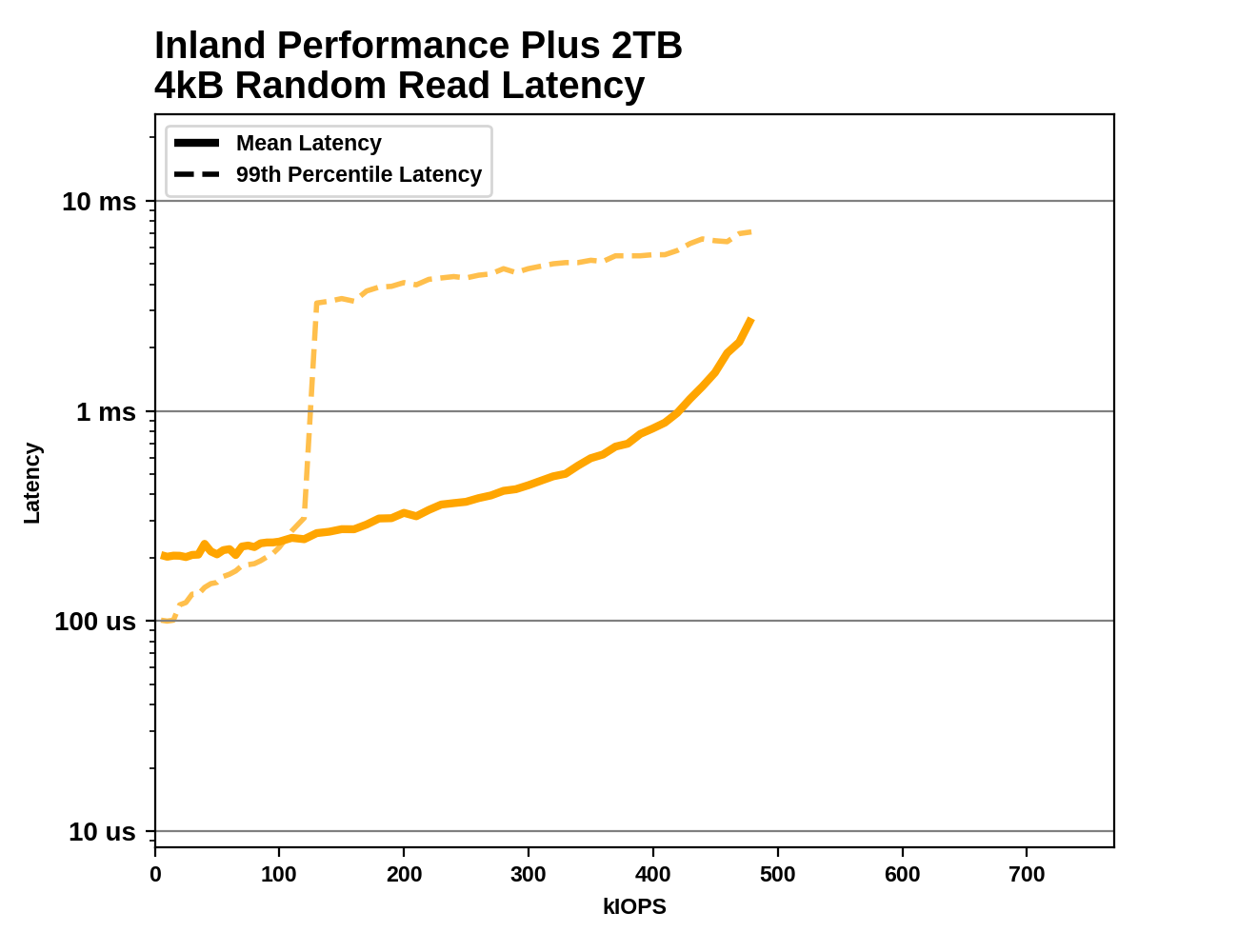The Inland Performance Plus 2TB SSD Review: Phison's E18 NVMe Controller Tested
by Billy Tallis on May 13, 2021 8:00 AM ESTBurst IO Performance
Our burst IO tests operate at queue depth 1 and perform several short data transfers interspersed with idle time. The random read and write tests consist of 32 bursts of up to 64MB each. The sequential read and write tests use eight bursts of up to 128MB each. For more details, please see the overview of our 2021 Consumer SSD Benchmark Suite.
 |
|||||||||
| Random Read | Random Write | ||||||||
| Sequential Read | Sequential Write | ||||||||
On the QD1 burst IO tests, the Inland Performance Plus tops the charts for both random and sequential writes, though in the latter case performance drops quite a lot when the drive is mostly full. Random read performance is merely average, and sequential reads are disappointingly in last place.
Sustained IO Performance
Our sustained IO tests exercise a range of queue depths and transfer more data than the burst IO tests, but still have limits to keep the duration somewhat realistic. The primary scores we report are focused on the low queue depths that make up the bulk of consumer storage workloads. For more details, please see the overview of our 2021 Consumer SSD Benchmark Suite.
 |
|||||||||
| Random Read | Throughput | Power | Efficiency | ||||||
| Random Write | Throughput | Power | Efficiency | ||||||
| Sequential Read | Throughput | Power | Efficiency | ||||||
| Sequential Write | Throughput | Power | Efficiency | ||||||
On the longer IO tests that bring in some higher queue depths, the Performance Plus loses its first-place spot for random writes to the WD Black SN850, but it hangs on to first place for sequential writes. For both random and sequential reads it manages to improve its standings slightly, but the sequential read performance remains disappointing. Power efficiency isn't great on any of these four tests, but it's decent for sequential writes and more or less matches the flagship Gen4 drives from WD and Samsung.
 |
|||||||||
| Random Read | |||||||||
| Random Write | |||||||||
| Sequential Read | |||||||||
| Sequential Write | |||||||||
The Inland Performance Plus does eventually reach top-tier performance for sequential reads, but it requires higher queue depths than the 980 PRO or SN850. For sequential writes, it has taken a clear lead by QD4 and maintains higher performance than any of the other drives can hit, with only a slight drop at the end of the test suggesting that the SLC cache might be starting to run out.
For random reads and writes, the Performance Plus simply doesn't scale up as high as its competitors, even with very large queue depths. The Samsung 980 PRO's maximum random write speeds are well beyond what any other drive hits, and for random reads the WD Black SN850 has a similarly large lead over the competition.
Random Read Latency
This test illustrates how drives with higher throughput don't always offer better IO latency and Quality of Service (QoS), and that latency often gets much worse when a drive is pushed to its limits. This test is more intense than real-world consumer workloads and the results can be a bit noisy, but large differences that show up clearly on a log scale plot are meaningful. For more details, please see the overview of our 2021 Consumer SSD Benchmark Suite.
 |
|||||||||
At low rates, the mean latency from the Inland Performance Plus is actually higher than the 99th percentile latency, indicating there's a small number of extremely high-latency IOs skewing the average. The median latency starts at a very respectable 63µs, but the highest latency measured at low rates is close to 70ms—three orders of magnitude slower. This looks like the drive might be stalling while waking up from a sleep state, which it shouldn't even be entering given the minimal idle time between test phases. Above 120k IOPS, the 99th percentile latency jumps up to the millisecond range, which should only happen to a drive this high-end when it's pretty close to its maximum throughput. The Performance Plus does achieve respectable throughput that is a clear improvement over the Phison E16, but compared to WD and Samsung flagships the E18 drive is slower and has some mildly concerning performance quirks.










118 Comments
View All Comments
Spunjji - Friday, May 14, 2021 - link
Yes, that's why I said "most of us". I know there are use cases that benefit from them, but the majority of the time they don't apply to a majority of users.jabber - Friday, May 14, 2021 - link
Yeah you are correct, 'most users' do not notice and most don't need the speed but you will always get the one or two who, for some reason, choose to work with 8K video all day and think they are 'most users'.James5mith - Thursday, May 13, 2021 - link
Please add one of the new 5800x Optanes into the mix. I would like to see what Optane + PCIe4.0 can do as far as sustained performance.It's really sad that none of these drives can maintain performance except for the old 970 Pro and the Optane.
mode_13h - Thursday, May 13, 2021 - link
> Please add one of the new 5800x Optanes into the mix.It would be amusing to see a 4.3M IOPS drive compared to consumer SSDs. However, the pricing on those things is pretty nuts. If such performance is worthwhile for you, you already know you want one.
That said, I'm always interested in seeing cutting edge tech put to the test.
Tomatotech - Friday, May 14, 2021 - link
> maintain performanceAbsolutely not needed for the average price-sensitive user. It’s like buying a 40-ton truck instead of an average family car. And the average family car will outperform the truck in acceleration, top speed, fuel economy, and ease of storage / parking.
There’s many drives available for people who need 100% sustained performance or other industrial metrics and they’re going to cost a bit more.
DigitalFreak - Thursday, May 13, 2021 - link
I'm waiting on DirectStorage before I upgrade.mode_13h - Thursday, May 13, 2021 - link
Why?RSAUser - Friday, May 14, 2021 - link
Because there is no real-world gain for most people going from a normal PCIe 3 SSD to PCIe 4 SSD right now, they're within ms of each other.If DirectStorage starts taking off, it could maybe have a more noticeable impact in terms of texture loading, etc.
mode_13h - Saturday, May 15, 2021 - link
I guess it also depends on what you're upgrading from.It amazes me how some people complain that it's not worth upgrading a CPU (for example), when they have one from the preceding generation! I'm like: well, join the crowd! Most of us keep hardware for *multiple* generations.
So, I find it's also worth keeping in mind that people complaining that it's not worth upgrading might be bringing unrealistic expectations.
thestryker - Thursday, May 13, 2021 - link
I'm not sure the feasibility, but I'd be really curious to see how the PCIe 4 SSD performance varies between AMD and Intel. I know some of Intel's nebulous marketing materials had suggested RKL was better than the Ryzen alternatives, and while I highly doubt that I haven't seen any reviewers test out the same drive on both platforms.I'd also like to second that dream that you'll be able to run a P5800X through the test suite.